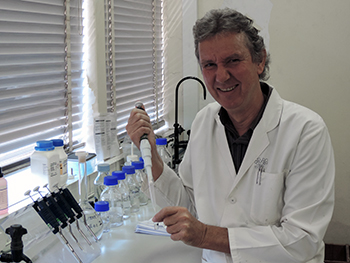
Prof Gary Osthoff from the UFS Department of
Microbial, Biochemical and Food Biotechnology,
will soon work on a milk formula for elephants.
Photo: Supplied
Research is being done at the University of the Free State (UFS) to analyse and synthetically imitate the unique milk of various wildlife species. This research is not only of scientific value, but also serves the conservation of South Africa’s wildlife species. At the forefront of this research is Prof Garry Osthoff from the Department of Microbial, Biochemical and Food Biotechnology.
Orphaned rhino calf pulled through with surrogate milk
“There is still a lot of research to be done. Naturally the research is of scientific importance, but with surrogate milk having the same composition as the mother’s milk of a specific species, orphaned calves or cubs of that species could be pulled through during a difficult time of weaning. Bearing in mind that exotic animals fetch thousands and even millions of rands at auctions, it goes without saying a game farmer will do everything possible to provide only the best nourishment to such an orphaned animal. In such a case, synthetically-manufactured milk would be the right choice,” says Prof Osthoff.
The fruits of his research were recently demonstrated in Germany when a rhino calf was left orphaned in the Leipzig Zoo. Prof Osthoff’s article: “Milk composition of a free-ranging white rhinoceros during late lactation” was used as a directive for applying surrogate milk for horse foals (which is already commercially available), since the composition of horse and rhino milk largely corresponds. The surrogate milk was used with great success and the rhino calf is flourishing. He mentions that such an orphan is often given the wrong nourishment with the best intentions, resulting in the starvation of the animal despite the amount of cow’s milk it devours.
With surrogate milk having the same
composition as the mother’s milk of a
specific species, orphaned calves or
cubs of that species could be pulled
through during the difficult time
of weaning.
Milk formula for baby elephants in the pipeline
With baby elephants left orphaned due to the increase in elephant poaching for their ivory, several attempts have been made to create a milk formula in order to feed these elephants. To date, many elephants have died in captivity from side effects such as diarrhoea as a result of the surrogate formula which they were fed.
Prof Osthoff recently received a consignment of frozen milk which he, together with researchers from Zimbabwe, will use to work on a milk formula for elephants. They are studying the milk in a full lactation period of two years. During lactation, the composition of the milk changes to such an extent that a single surrogate formula will not be sufficient. Four different formulas should probably be designed.
Prof Osthoff says that of the different species he has researched, elephants are the most interesting and deviate most from the known species.
Although his research to develop surrogate milk is adding much value to the wildlife industry, and although he finds this part of his work very exciting, his research focus is on food science and nutrition. “What is currently authentic in milk research is the study of the fat globules with content, the structure and composition of the casein micelle, and the prebiotic sugars. The knowledge which is gained helps to improve the processing, development of new food products, and development of food products for health purposes,” says Prof Osthoff.